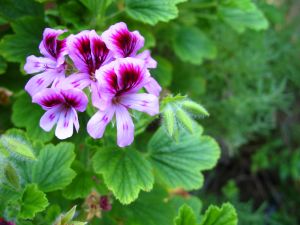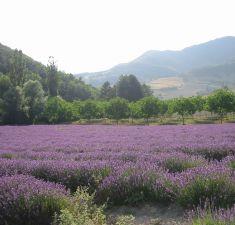Interesting Facts about Geranium Essential Oil
An Introduction - Ancient and Traditional uses around the world.
Geranium Essential Oil
Originally from South Africa - brought to Holland in the sixteenth century on the trading ships which loaded cargo at the Cape of Good Hope. There are over two hundred varieties of perlagonium. Perlagonium graveolens is discussed here.
The generic name Perlagonium comes from the Greek word " perlagos " meaning stork. The seed pods of the geranium have a similar shape to storks' beaks hence the association.
John Tradescant the Elder, English naturalist, royal gardener and traveller brought seeds back from Paris in 1631 and introduced the plant to England. Culpepper writes of the advantages of using the plant to encourage wound healing .
Used in Eighteenth century England again as a healing plant, geranium was added to poultices for wounds and tumours. It was commonly used for treating haemarrhoids and inflammation of the skin which was recorded as giving very effective results.
The French began oil production of rose geranium in earnest in 1847, from an island in the Southwestern Indian Ocean called Ile de Bourbon - now called Ile de Reunion, hence another common name for geranium essential oil, Bourbon la Reunion.
The Victorians most notably used it within perfumes, to scent their drawing-rooms and as an insect repellant.
Now the perlagonium plant is widely grown notably in Reunion, Madagascar, Northern Africa, Russia and China as its oil is used in perfume production worldwide. Other commercial uses are as a flavouring agent in food, also to flavor alcohol and soft drinks.
In aromatherapy it is used as an anti-depressant, anti-haemorrhagic, anti-inflammatory, antiseptic, astringent, cicatrisant, deoderant, diuretic, fungicidal, haemostatic,
adrenal cortex stimulant, styptic, vermifuge and vulnerary.
Descriptions of the plant, its family and source.
Rose scented geranium also known as Storksbill - not to be confused with True geranium known as Cranesbill.
Latin name - Perlagonium Graveolens.
Family - Geraniaceae
There are over two hundred species of cultivated perlagoniums. Three main species used in oil production are Perlagonium Graveolens, Perlagonium Odorantissium and Perlagonium Radens.
Perennial shrub. One metre high. Small pink flowers, wide and pointed serrated leaves.
Principal constituents and method of extraction.
Geraniol, citronellol, linalool, sabinene, phellandrene, eugenol, menthone.
Steam distillation of leaves, stalks and flowers producing a light-green oil with a minty-rose scent.
Follow the links below to discover how to use essential oils in your home, for beauty and health, for cooking, for cleaning, in soapmaking and also how to grow herbs. This wonderful aromatic herb deserves a place in everyones home.
Why not go to the Make Soap page, see the link below to try some easy Olive Oil based recipes.
All of the recipes use only Olive Oil, Essential Oils and Herbs, there are many to choose from, if you
would like know more about each respective herb or oil take a look at the navigation bar on the
left-hand side of the page to find out more.
Go to the Make Soap page from Geranium Essential Oil.
Go to The Mediterranean Diet Foods Cookbook Page
Go to Uses of Olive Oil Page - discover the myriad of uses for olive oil.
Go to The Sitemap page
Go to Anayennisi-Aromatics Home from Geranium Essential Oil








